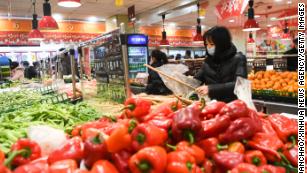The coronavirus pandemic could threaten global food supply, UN warns
As the novel coronavirus pandemic shuts down businesses globally and sends countries into lockdown, the disruptions are threatening to cut off supply chains and increase food insecurity.
"Supermarket shelves remain stocked for now," the Food and Agriculture Organization of the United Nations (FAO) said in a report released late last month. "But a protracted pandemic crisis could quickly put a strain on the food supply chains, a complex web of interactions involving farmers, agricultural inputs, processing plants, shipping, retailers and more."
The issue, however, is not food scarcity -- at least, not yet. Rather, it's the world's drastic measures in response to the virus.
Border closures, movement restrictions, and disruptions in the shipping and aviation industries have made it harder to continue food production and transport goods internationally -- placing countries with few alternative food sources at high risk.
Airlines have grounded thousands of planes and ports have closed -- stranding containers of food, medicine, and other products on tarmacs and holding areas, said the UN Conference on Trade and Development on March 25.
Heightened instability in global food supply will affect the poorest citizens most, warned the UN's Committee on World Food Security (CFS) in a paper last month.
Even private companies and organizations have called for immediate action to address the looming food catastrophe.
"Governments, businesses, civil society and international agencies need to take urgent, coordinated action to prevent the COVID pandemic turning into a global food and humanitarian crisis," said an open letter to world leaders from scientists, politicians, and companies like Nestle and Unilever.
China's technological advances softened the blow
China was worst-hit by the virus in January and February, when thousands of new cases were being reported each day.
The country imposed lockdowns, suspended inter-provincial trave and ordered residents to stay at home, disrupting business in virtually all sectors.
"In China, logistics constraints and labor crunches have caused losses of fresh vegetables, limited access to animal feed and diminished capacity of slaughterhouses," said the FAO report.
China has faced severe food shortages before; historians estimate tens of millions of people starved to death in a famine caused by an economic campaign known as the Great Leap Forward, from 1958 to 1962.
Food prices are soaring in China because of the coronavirus and swine fever
But modern China is an entirely different country, with new technologies and wealth -- and it has been working for years to improve its food security, spending tens of billions of dollars this past decade purchasing major seed businesses.
These efforts appear to have softened the blow to the food industry this time around. The central government distributed $20 million in subsidies to revive agriculture, and invested in technology including agricultural drones and unmanned vehicles that could keep supply chains moving without human contact, said the FAO report.
When people did go into the fields to work, they wore government-provided masks and protective equipment, and were given disinfectant from local authorities, said state-run news agency Xinhua.
Even the country's dominant e-commerce market stepped in; provincial lockdowns and movement restrictions hampered the export and transport of goods, so e-commerce giant Alibaba set up a fund to help farmers find markets for their unsold products, the report said.
Australia is facing export pressure
Australia exports about two thirds of its agricultural products and is a major supplier for the Asia Pacific region -- but this crucial trade is now under threat.
The aviation industry has been hit hard by the pandemic and international flights have been slashed. Fewer flights mean it's now more expensive to export food via air travel, said Richard Shannon, manager of policy and advocacy at Growcom, the representative body for horticulture in Queensland state.
"The industry is rapidly trying to find alternate routes," he said -- but some Australian farmers may try to find new buyers within the country instead of looking internationally.
This threatens the entire country's economy in two ways. About 14.5% of all Australian exports are food products, according to the Observatory of Economic Complexity (OEC). If farmers aren't able to export their goods, it could cost the country tens of billions of dollars in lost income.
The next best option is for farmers to sell their goods within Australia -- so all these agricultural products that typically are sent out into the world are suddenly entering the domestic market. This influx could put a lot of pressure on the market, and affect the price at which these goods are sold, Shannon said.
The government stepped in with emergency aid, announcing it would spend 110 million Australian dollars ($67.4 million) to increase the number of flights and help exporters transport their goods to key international markets.
But the pandemic has also posed other problems. Winter is arriving in Australia -- which means seasonal workers nationwide are flocking to Queensland, which grows more than 90% of the country's winter vegetables. Suddenly, small rural towns are booming with people arriving from out of state, looking for work on farms.
News Courtesy: www.cnn.com












